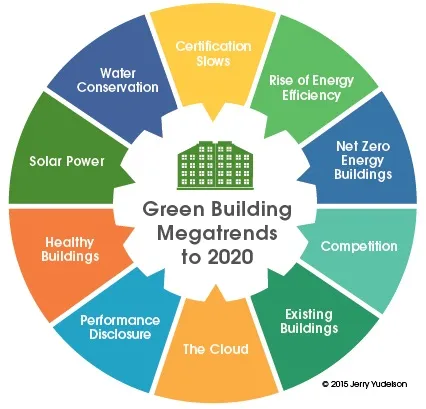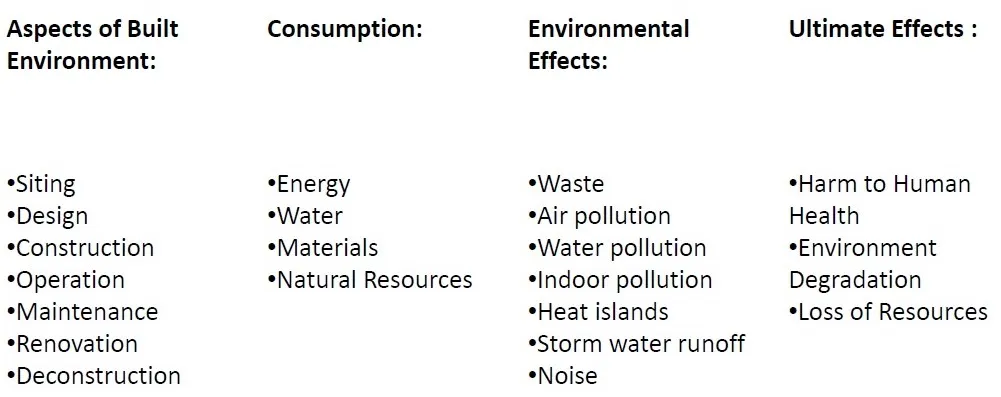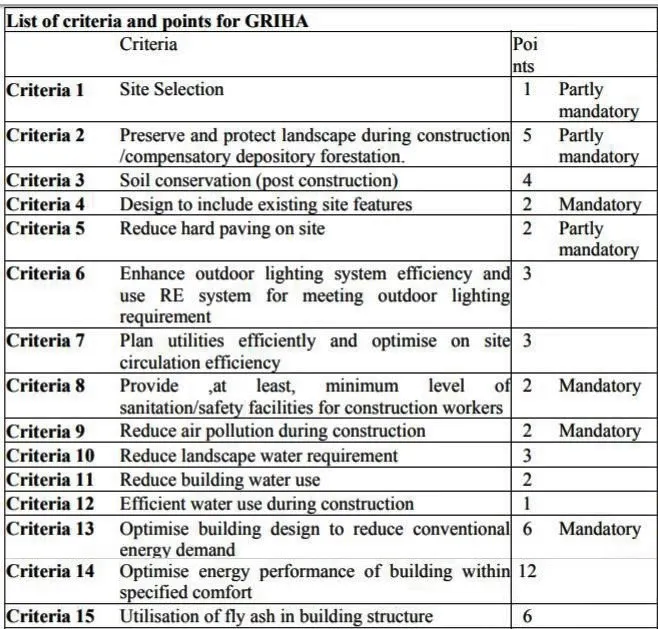If you want to know about the rating process and rating structure of GRIHA or about the green building or energy optimization, please click the link.
GRIHA, also known as Green Rating for Integrated Habitat Assessment, is a rating system for evaluating the environmental performance of buildings in India. It provides a tool for designers, architects, engineers, and building owners to assess the environmental performance of their buildings and make informed decisions about design, construction, and operations.
- Green building refers to both a structure and the application of processes that are environmentally responsible and resource-efficient throughout a building’s lifecycle: from planning to design, construction, operation, maintenance, renovation, and demolition.

1) Objective of green buildings
- Efficiently using energy, water, and other resources
- Protecting occupant health and improving employee productivity (see healthy building)
- It is designed using an integrated approach
- Reducing waste, pollution and environmental degradation
i) Impact of the built Environment

ii) There are three primary Rating systems in India
- GRIHA [Green Rating for Integrated Habitat Assessment]
- IGBC [Indian Green Building Council]
- BEE [Bureau of Energy Efficiency]
2) GRIHA [Green Rating for Integrated Habitat Assessment]
Green Rating for Integrated Habitat Assessment (GRIHA) is India’s own rating system jointly developed by TERI and the Ministry of New and Renewable Energy, Government of India. GRIHA rating system consists of 34 criteria categorized in four different sections.
- Site selection and site planning
- Conservation and efficient utilization of resources
- Building operation and maintenance
- Innovation.

i) Benefits of a green design to a building owner, user, and the society
- Reduced energy consumption without sacrificing the comfort levels
- Reduced destruction of natural areas, habitats, and biodiversity, and reduced soil erosion, etc.
- Reduced air and water pollution (with direct health benefits)
- Reduced water consumption
- Limited waste generation due to recycling and reuse
- Reduced pollution loads
- Increased user productivity
- Enhanced image and marketability
ii) Scoring points for GRIHA

3) Evaluation procedure of criterion of GRIHA



4) Function of the GRIHA
The primary function of GRIHA is to promote sustainable design and construction practices in the built environment, with a focus on reducing the environmental impact of buildings.
- The rating system evaluates a building’s performance in areas such as energy efficiency, water management, indoor air quality, and material use, among others.
- It also takes into account the building’s location, orientation, and surrounding environment to provide a comprehensive assessment of its overall sustainability.
5) GRIHA Green Building Rating System
GRIHA provides a series of guidelines and performance criteria that buildings must meet in order to achieve a certain rating, ranging from one star (the lowest rating) to five stars (the highest rating).
The rating system provides a roadmap for buildings to improve their environmental performance over time, and incentivizes the adoption of sustainable practices through recognition and recognition through the rating system.
i) Conservation and efficient utilization of resources
Objective : To maximize the conservation and utilization of resources (land, water, natural habitat, fauna, and energy) conservation and enhance efficiency of the systems and operations. Criteria 1 to 7 is flows for conservation and efficient utilization of resources
Criteria – 1
- Site Selection: Site should be located within ½ km radius of an existing or planned and funded bus stops, commuter rail, light rail or metro station
Criteria – 2
- Preserve and protect the landscape during construction / compensatory depository forestation. Proper timing of construction, preserve top soil and existing vegetation erosion and sedimentation control.
Criteria – 3
- Soil conservation (till post-construction) Proper top soil laying and stabilization of the soil and maintenance of adequate fertility of the soil to support vegetative growth.
Criteria – 4
- Design to include existing site features. Minimize the disruption of natural ecosystem and design to harness maximum benefits of the prevailing micro-climate.
Criteria – 5
- Reduce hard paving on-site and /or provide shaded hard- paved surfaces. Minimize storm water run-off from site by reducing hard paving on site
Criteria – 6
- Enhance outdoor lighting system efficiency. use of a renewable energy -based lighting system
Criteria – 7
- Plan utilities efficiently and optimize on-site circulation efficiency. Minimize road and pedestrian walkway length
ii) Health and well being
Objectives : To protect the health of construction workers and prevent pollution.
Criterion – 8
- Provide at least, the minimum level of sanitation/safety facilities for construction workers. Ensure cleanliness of workplace with regard to the disposal of waste and effluent, provide clean drinking water and latrines and urinals as per applicable standard.
Criterion – 9
- Reduce air pollution during construction. Ensure proper screening, covering stockpiles, covering brick and loads of dusty materials, wheel-washing facility, water spraying.
iii) Efficient utilization of resources
Objective : To maximize resource (water, energy, and materials) conservation and enhance efficiency of the system and operations.
Criterion – 10
- Reduce landscape water requirement. Landscape using native species and reduce lawn areas while enhancing the irrigation efficiency, reduction in water requirement for landscaping purposes.
Criterion – 11
- Reduce building water use. Reduce building water use by applying low-flow fixtures, etc.
Criterion – 12
- Efficient water use during construction. Use recycled treated water and control the waste of curing water
Criterion – 13
- Optimize building design to reduce the conventional energy demand. Plan appropriately to reflect climate responsiveness, adopt an adequate comfort range, less air-conditioned areas, day lighting etc.
Criterion – 14
- Optimize the energy performance of the building within specified comfort limits.
Criterion – 15
- Utilization of fly ash in the building structure.
- Use of fly ash for RCC
Criterion – 16
- Reduce volume, weight, and time of construction by adopting an efficient technology (e.g. pre-cast systems, ready-mix concrete, etc.). Replace a part of the energy-intensive materials with less energy intensive materials.
Criterion – 17
- Use low-energy material in the interiors. low-energy materials/finishes to minimize the usage of wood.
Criterion – 18
- Renewable energy utilization.
Criterion – 19
- Renewable energy – based hot- water system. Meet 20% or more of the annual energy required for heating water through renewable energy based water-heating systems.
iv) Recycle, Recharge, and Reuse of water
Objective : To promote the recycle and reuse of water.
Criterion – 20
- Waste- water treatment : Provide necessary treatment of water for achieving the desired concentration of effluents
Criterion – 21
- Water recycle and reuse (including rainwater).
Criterion – 22
- To minimize waste generation, streamline waste segregation, storage, and disposal, and promote resource recovery from waste.
Criterion – 23
- Reduction in waste during construction.
Criterion – 24 (Efficient waste segregation)
- Use different colored bins for collecting different categories of waste from the building
Criterion – 25 (Storage and disposal of waste)
- Allocate separate space for the collected waste before transferring it to the recycling/disposal stations.
Criterion – 26 (Resource recovery from waste)
- Make arrangements for recycling of waste through local dealers.
v) Health and well-being
Objective : To ensure healthy indoor air quality, water quality, and noise levels, and reduce the global warming potential.
Criterion – 27
- Minimize ozone depleting substances.
Criterion – 28
- Ensure water quality.
- In case the water quality cannot be ensured, provide necessary treatment of raw water for achieving the desired concentration for various applications.
Criterion – 29
- Acceptable outdoor and indoor noise levels.
Criterion – 30
- Tobacco and smoke control.
Criterion – 31
- Universal accessibility To ensure accessibility and usability of the building and its facilities by employees, visitors and clients with disabilities.
vi) Building operation and maintenance
Objective : Validate and maintain ‘green’ performance levels/adopt and propagate green practices and concepts.
Criterion – 32
- Energy audit and validation.
Criterion – 33
- Operation and maintenance protocol for electrical and mechanical equipment.
Criterion – 34 (Innovation)
- Alternative transportation
- Environmental education
- Company policy on green supply chain
- Life cycle cost analysis
- Any other criteria proposed by applicant
Overall, GRIHA plays a critical role in promoting sustainable design and construction practices in India, and serves as a model for other countries looking to promote sustainability in the built environment.